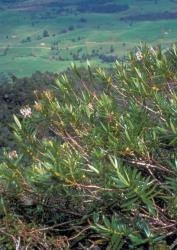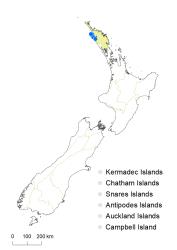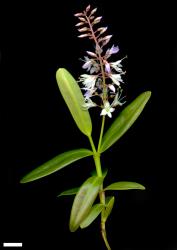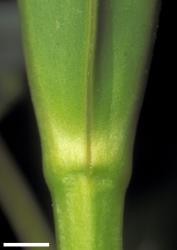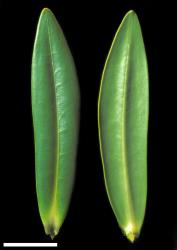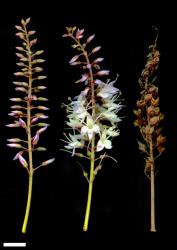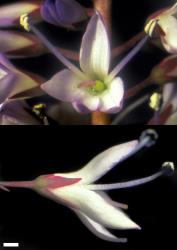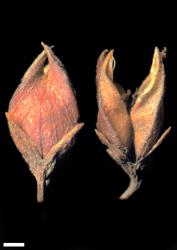- Taxon
- Gallery
- ≡ Hebe perbella de Lange, New Zealand J. Bot. 36: 399 (1998)
Bushy shrub to 1.8 m tall. Stems erect, glabrous. Leaf bud distinct, its leaves appressed until fully grown; sinus absent. Leaves opposite-decussate, erecto-patent to spreading; lamina coriaceous, elliptic or narrowly oblanceolate, 35–110 mm long, 7–23 mm wide, glossy dark green above, dull pinkish-green beneath; midrib and faint pinnate secondary veins evident; surfaces glabrous except for minute glandular and eglandular hairs along midrib above; margin glabrous, entire; apex acute to obtuse; base cuneate; petiole absent or indistinct, 1–2 mm long. Inflorescence a lateral raceme, 60–150 mm long; flowers more or less crowded, 15–80, all bisexual; bracts alternate to loosely whorled, lanceolate, < pedicels; pedicels spreading, 2–5 mm long, minutely puberulent all around. Calyx lobes 4 or occasionally small posterior 5th lobe present, narrowly acute to acuminate, 2.2–3.8 mm long, equal, with sparse, minute, sessile glandular hairs on face, mixed glandular- and eglandular-ciliolate. Corolla 5–9 mm diameter; tube white, 1.8–2.2 mm long, ≤ calyx, eglandular-puberulent inside; lobes 4, purplish, sometimes pink, red, or carmine, fading to whitish, erect or sub-erect, reflexed with age, unequal, lanceolate to narrowly ovate, 4.8–6.5 mm long, acute; nectar guides absent. Stamen filaments purplish, 7–10 mm long; anthers blue to purple. Style glabrous, 8–10 mm long. Capsules latiseptate, acute, glabrous except for a few short eglandular hairs in septal groove, 7–8 mm long, 5–6 mm at widest point. Seeds ovate, flattened, weakly papillate, pale brown, 1.8–2.0 mm long.
adamsii | macrocarpa | perbella | saxicola | |
|---|---|---|---|---|
Stem hairs | uniformly to bifariously puberulent or glabrous | uniformly to bifariously puberulent | glabrous | usually glabrous or rarely bifarious-puberulent |
Leaf bud sinus | present | absent | absent | absent |
Lamina (above) | glossy | glossy | glossy | dull |
Calyx colour | dark green or bronze-green | yellow-green | pink, reddish, violet, or red- to brown-green | yellowish- to dark green |
Calyx lobes outer surface | minute sessile glands | glabrous or eglandular-puberulent | minute sessile glands | minute sessile glands |
Corolla colour | white to mauve, rarely violet | white, rarely lilac, sometimes tinged lilac or pink | violet-red, violet, pink, deep mauve, very rarely carmine | pale lavender (rarely lilac) |
Corolla tube | ≤ calyx; hairy inside | > calyx; hairy inside | ≤ calyx; hairy inside | < calyx; glabrous inside |
Corolla lobes | subacute | obtuse to rounded | acute | subacute or bluntly acute |
Capsule | glabrous | glabrous | glabrous except for a few short hairs along septal grooves | glabrous |
Distribution | far North, known only from four sites, all within 1 km2, west of Spirits Bay | southern Northland from Whangārei and southern Kaipara Harbour southwards to South Auckland, Coromandel, and near Kawhia | western Northland between Ahipara and Waima Forest | known only from Maungaraho Rock, near Dargaville |
North Island: Northland (Ahipara, Herekino Forest, Warawara Forest, Waimā Forest). Formerly present also at Kaitaia (de Lange & Rolfe 2008).
Rock outcrops and shallow soils in cloud forest, also in kauri forest and gum-land scrub. Recorded elevations range from 100 to 690 m.
Flowers: March–December; fruits: May–March.
2n = 40 (see Bayly & Kellow 2006, as Hebe perbella).
Veronica perbella is classified in V. subg. Pseudoveronica sect. Hebe and the informal group “Occlusae” (Albach & Meudt 2010; Bayly & Kellow 2006).



